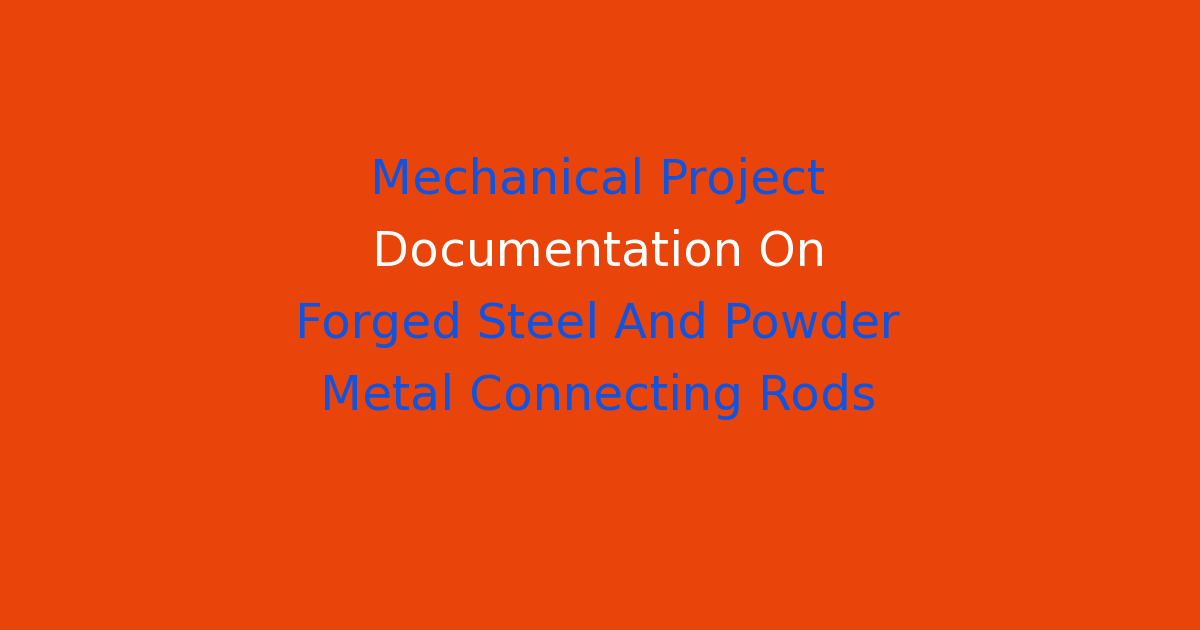Documentation for mechanical project involving forged steel and powder metal connecting rods.
Introduction
In the field of mechanical engineering, connecting rods play a crucial role in the functioning of internal combustion engines. These rods are responsible for transferring power from the piston to the crankshaft, ensuring the smooth operation of the engine. Traditionally, connecting rods have been made using forged steel, which has been the preferred material due to its strength and durability. However, with advancements in technology, powder metal connecting rods have emerged as a viable alternative due to their potential for cost reduction and improved performance.
Problem Statement
While forged steel connecting rods have been widely used in the industry, they come with certain limitations. The traditional forging process is time-consuming and labor-intensive, resulting in higher production costs. Additionally, forged steel rods are heavy and can lead to increased fuel consumption and reduced efficiency in the engine. There is a need for a more efficient and cost-effective solution that can overcome these drawbacks while maintaining the required strength and performance.
Existing System
Forged steel connecting rods have been the standard choice for engine manufacturers for many years. The forging process involves heating a steel billet and shaping it under high pressure to form the desired rod. While this method produces rods with high tensile strength and fatigue resistance, it is a costly and time-intensive process. Furthermore, forged steel rods are heavier than other materials, contributing to increased inertia and lower engine performance.
Disadvantages of Forged Steel Connecting Rods
- High production costs
- Time-consuming manufacturing process
- Heavy weight leading to reduced engine efficiency
- Potential for material defects and inconsistencies
Proposed System
One alternative to forged steel connecting rods is the use of powder metal technology. Powder metal connecting rods are made by compressing metal powders into a mold and then sintering them at high temperatures to create a solid piece. This process offers several advantages over traditional forging, including lower production costs, reduced material waste, and improved design flexibility. Powder metal rods are also lighter in weight, helping to enhance engine performance and fuel efficiency.
Advantages of Powder Metal Connecting Rods
- Lower production costs
- Reduced material waste
- Lighter weight for improved engine performance
- Enhanced design flexibility
Features of Powder Metal Connecting Rods
Powder metal connecting rods are characterized by their high strength, durability, and precision. The powder metallurgy process allows for the creation of complex shapes and intricate designs, enabling engineers to optimize the performance of the rod for specific engine requirements. Additionally, powder metal rods offer excellent fatigue resistance and dimensional stability, ensuring reliable operation under high stress conditions.
Conclusion
In conclusion, the use of powder metal technology for connecting rods presents a promising alternative to traditional forged steel rods. The cost-effective manufacturing process, lightweight design, and superior performance characteristics make powder metal rods an attractive option for engine manufacturers looking to improve efficiency and reduce production costs. By embracing innovative materials and processes, the automotive industry can drive further advancements in engine design and performance, ultimately benefiting consumers with more reliable and fuel-efficient vehicles.

